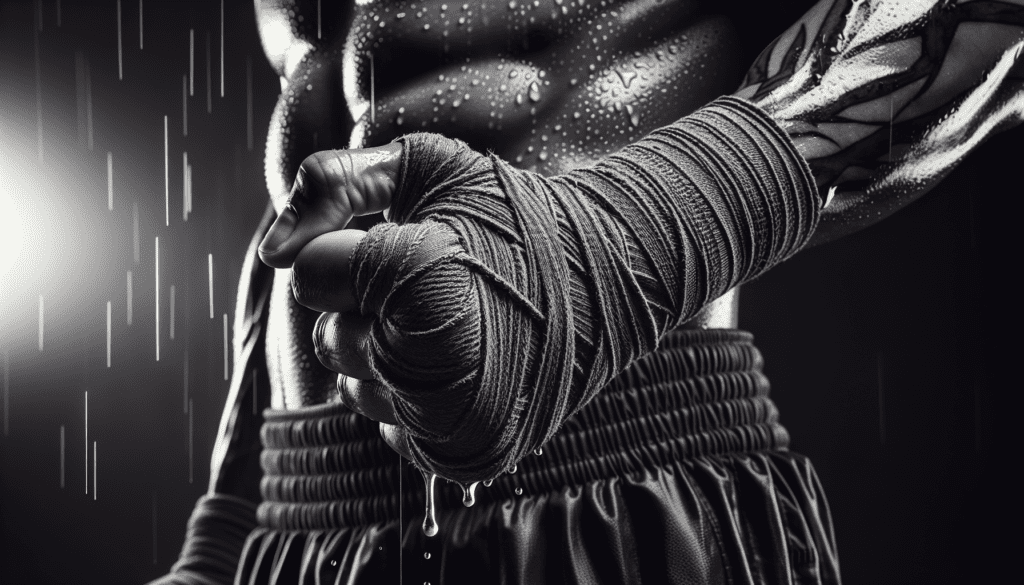In the fast-paced world of mixed martial arts (MMA), tendon injuries can be all too common and detrimental to a fighter’s career. That’s why it’s crucial to equip yourself with the knowledge and strategies to prevent these injuries from derailing your journey in the octagon. This article will provide you with the best practices for avoiding tendon injuries in MMA, empowering you to protect your body and maximize your performance in the ring. Whether you’re a seasoned professional or just starting out, implementing these practices will give you the edge you need to stay injury-free and excel in the world of MMA.

Proper Warm-up
Before any MMA training session, it is essential to properly warm up your muscles and prepare your body for the intense physical demands it will face. A proper warm-up routine should include dynamic stretching, light aerobic exercises, and joint mobility exercises.
Dynamic stretching involves moving your muscles through a full range of motion, rather than holding a single stretch position. This helps to increase blood flow and oxygen to the muscles, improving their flexibility and reducing the risk of injury. Some dynamic stretches that are beneficial for MMA include leg swings, arm circles, and hip rotations.
Light aerobic exercises, such as jogging or jumping jacks, help to elevate your heart rate and warm up your entire body. This increased blood flow brings essential nutrients and oxygen to your muscles, preparing them for the physical demands of the training sessions ahead.
Joint mobility exercises focus on loosening and lubricating the joints, allowing for smoother and more fluid movements during training. These exercises can include wrist circles, shoulder rolls, and ankle rotations. Taking the time to properly prepare your muscles and joints with a warm-up routine will help prevent tendon injuries and improve your overall performance in MMA.
Technique and Form
One of the key factors in avoiding tendon injuries in MMA is using proper technique and form during training. Every movement, from striking to grappling, should be executed with precision and control. This not only improves the effectiveness of your techniques but also reduces the strain on your tendons and ligaments.
Correct posture and body alignment are crucial to preventing tendon injuries. Maintaining a neutral spine, engaging your core, and distributing your weight evenly across your body can help minimize undue stress on your tendons. It is essential to focus on proper positioning and body mechanics to avoid overloading specific muscle groups and putting unnecessary strain on your tendons.
Regular technique drills are instrumental in developing muscle memory and reinforcing correct movement patterns. By consistently practicing the proper execution of various techniques, you can improve your muscle recruitment, coordination, and proprioception. This allows you to perform movements more efficiently and with reduced stress on your tendons.
Strength and Conditioning Training
A well-rounded strength and conditioning program is vital for preventing tendon injuries in MMA. By building overall strength and improving your body’s ability to withstand physical stress, you can reduce the risk of tendon damage.
A balanced training program should include exercises that target all major muscle groups and movement patterns. By focusing on both pushing and pulling movements, as well as upper and lower body exercises, you create a balanced musculature that can support and protect your tendons.
Progressive overload is another important principle to follow in your strength training. Gradually increasing the intensity, volume, or complexity of your exercises challenges your muscles and tendons to adapt and become stronger over time. However, it is crucial to progress gradually and avoid excessive loading that can lead to tendon injuries.
Targeted exercises for tendon strength can also be incorporated into your training routine. Specific exercises that strengthen the tendons, such as wrist curls for the forearm tendons or calf raises for the Achilles tendon, can help improve their resilience and reduce the risk of injury.
Gradual Progression
To avoid tendon injuries, it is crucial to adopt a slow and controlled approach to training intensity. Rapid increases in training volume or intensity can overload your tendons and lead to injury. Gradual progressions allow your tendons to adapt and strengthen at a pace that is sustainable for your body.
Periodization of training is an effective way to manage training intensity and prevent overloading your tendons. By dividing your training into different phases, such as a strength-building phase, a conditioning phase, and a restorative phase, you can ensure that your tendons have adequate time to recover and adapt to the demands placed upon them.
Listening to your body’s signals is essential when it comes to avoiding tendon injuries. If you feel persistent pain or discomfort in a particular tendon, it is crucial to reduce the intensity or take a break from training altogether. Ignoring these signals and pushing through the pain can lead to further damage and a longer recovery time.

Proper Nutrition and Hydration
Proper nutrition and hydration play a significant role in tendon health and injury prevention in MMA. Adequate protein intake is essential for the repair and maintenance of tendons. Including lean sources of protein, such as chicken, fish, and tofu, in your diet can provide the necessary building blocks for tendon health.
In addition to protein, sufficient hydration is crucial for maintaining proper tissue hydration. Dehydration can lead to decreased flexibility and elasticity in tendons, making them more susceptible to injury. Aim to drink water regularly throughout the day, especially before, during, and after training sessions.
A balanced diet that includes a variety of fruits, vegetables, whole grains, and healthy fats is essential for overall health and can support the health of your tendons. Adequate intake of vitamins and minerals, such as vitamin C and zinc, can also promote tendon health and repair.
Rest and Recovery
Rest and recovery are vital components of any training program, especially when it comes to preventing tendon injuries. Adequate rest days between training sessions allow your tendons time to recover and rebuild. Overtraining without proper rest can lead to overuse injuries, including tendonitis.
Quality sleep is crucial for tissue repair and regeneration. During sleep, your body releases growth hormone, which plays a significant role in tissue repair and muscle recovery. Aim for seven to nine hours of quality sleep each night to ensure optimal recovery and support healthy tendons.
In addition to passive rest, incorporating active recovery techniques can help promote blood flow and loosen tight muscles or tendons. Techniques such as foam rolling, stretching, or low-intensity activities like walking or swimming can aid in the recovery process and prevent potential tendon injuries.
Protective Gear
Using the appropriate protective gear can significantly reduce the risk of tendon injuries in MMA. Quality gloves provide hand protection and support, preventing unnecessary strain and damage to the tendons in your hands and wrists. Choose gloves that fit properly and provide adequate padding and wrist support.
A properly fitted mouthguard is essential for protecting your teeth, jaw, and potentially preventing concussions. Impact to the head and jaw can generate significant forces throughout the body, including the tendons. Wearing a mouthguard can help absorb and distribute these forces, reducing the risk of tendon injuries.
Supportive braces or wraps can also be beneficial in providing additional stability and support to vulnerable tendons, such as those in the ankles or wrists. These can help reduce excessive movement or strain on the tendons during training or competition, decreasing the likelihood of injury.
Avoid Overtraining
Overtraining is a significant risk factor for tendon injuries in MMA. It is vital to listen to your coach or trainer’s advice regarding training volume and intensity. They can help guide you through a well-structured training program that gradually increases in intensity while ensuring adequate recovery.
Monitoring your training load and recovery is essential to avoid overtraining and potential tendon injuries. Tracking the duration, frequency, and intensity of your training sessions can help you identify any patterns of overloading and make adjustments accordingly. In addition, paying attention to your body’s feedback and taking regular breaks when needed is crucial for injury prevention.
Avoiding Overuse
In MMA, using varied training modalities and techniques can help prevent overuse injuries, including tendon injuries. Alternating between high-impact and low-impact activities can help distribute the stress across different muscle groups and reduce the strain on specific tendons.
It is also important to alternate the muscle groups you target during training sessions. By giving each muscle group sufficient rest between sessions, you can prevent overloading the tendons associated with those muscles. For example, if you focus on heavy bag work one day, prioritize grappling or lower body exercises the next day.
By incorporating variety into your training routine, you can ensure that your tendons have a chance to recover and adapt to different demands, reducing the risk of overuse injuries.
Proper Injury Management
In the unfortunate event of a tendon injury, proper injury management is essential for optimal recovery and reducing the risk of re-injury. Seeking medical attention for any persistent pain or discomfort is crucial. Delaying proper diagnosis and treatment can lead to more severe damage and a longer recovery time.
Following appropriate rehabilitation protocols under the guidance of a medical professional or physical therapist is essential for restoring tendon health and function. Physical therapy exercises, such as eccentric strengthening exercises or stretching, can help improve tendon healing and prevent scar tissue formation.
Avoiding the temptation to return to training too soon is crucial for preventing further damage to the injured tendon. It is essential to follow the guidance of your healthcare provider and gradually reintroduce training activities once the injured tendon has healed sufficiently.
By following these best practices, including proper warm-up, technique and form, strength and conditioning training, gradual progression, nutrition and hydration, rest and recovery, protective gear, avoiding overtraining and overuse, as well as proper injury management, you can significantly reduce the risk of tendon injuries in MMA. Prioritizing tendon health and taking proactive measures to prevent injuries will not only improve your performance in MMA but also ensure a long and successful career in the sport.

